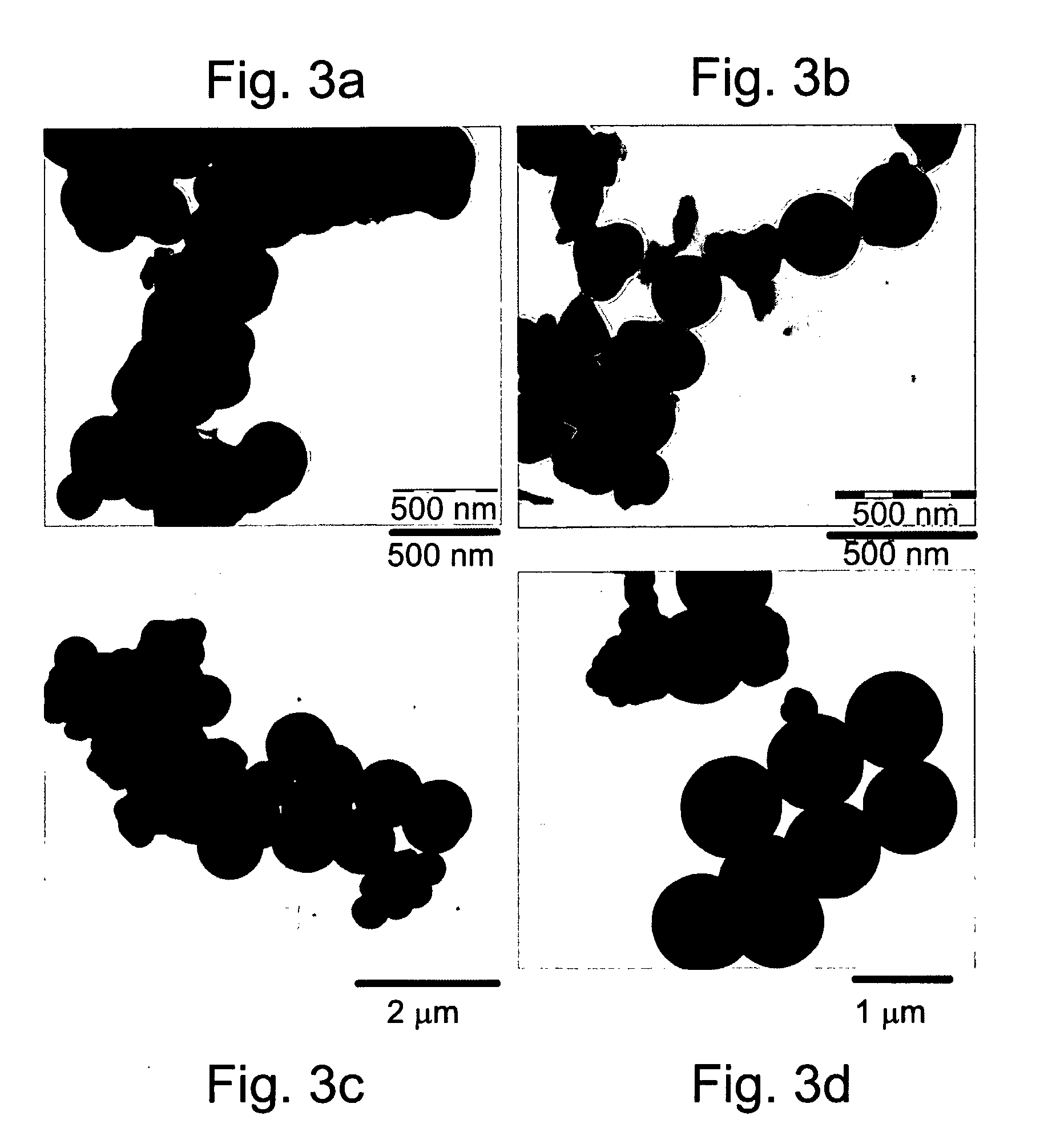Spherical composites entrapping nanoparticles, processes of preparing same and uses thereof
a composite material and nanoparticle technology, applied in the field of materials science, can solve the problems of inability to efficiently use nanocrystals in these applications, unstable photo-electronic characteristics, and less stable hydrophilic nanoparticles and particularly nanocrystals, and achieve the effect of unable optical functionality
- Summary
- Abstract
- Description
- Claims
- Application Information
AI Technical Summary
Benefits of technology
Problems solved by technology
Method used
Image
Examples
example 1
Preparation and Characterization of Sol-Gel / Polymer Composite Microspheres Entrapping Nanocrystals
Chemical Syntheses
[0306]Preparation of Nanocrystals:
[0307]Semiconducting nanocrystals that can impart optical functionality to the composite spheres were selected as exemplary nanocrystals for entrapment in the composites, taking advantage of the widely tunable band gap absorption and emission exhibited by the nanocrystals.
[0308]All nanocrystals were prepared, and / or coated with organic ligands, according to published procedures as follows:
[0309]CdSe nanocrystalline dots were prepared as described by Murray, C. B. et al. in J. Am. Chem. Soc., 1993, 115, 8706-8715.
[0310]CdSe / ZnS (core / shell, CS) nanocrystalline dots were prepared as described by Dabbousi, B. O. et al. in J. Phys. Chem., 1997, 8, 101, 9463-9475 and by Talapin, D. V. et al. in Nano Lett., 2001, 1, 207-211.
[0311]CdSe nanocrystalline rods were prepared as described by Peng, Z. A. and Peng, X. in J. Am. Chem. Soc., 2001, 123,...
example 2
Preparation of Sol-Gel / Polymer Composite Microspheres Entrapping Radioactive Nanocrystals
[0370]Encapsulation of radioactive nanocrystals (e.g., radioactive gold) is carried out according to the procedures described hereinabove.
[0371]Radioactive nanocrystals of 198Au are prepared as described by Cao Y. W. and Banin, U. in J. Am. Chem. Soc., 2000, 122, 9692.
[0372]In a typical example, ethanol (12.5 ml), aqueous ammonium hydroxide (2.5 ml, 25% by volume) and Tween80 (0.5 ml) are mixed in a 100 ml flask to give a hydrophilic solution.
[0373]In parallel, a solution of coated (hydrophobic) nanocrystals of 198Au (40 mg) in toluene (1.0 ml), TEOS (1.0 ml) and polystyrene (55 mg), is prepared in a separate vial to give a hydrophobic solution.
[0374]The hydrophobic solution is added to the hydrophilic solution at once and the resulting mixture is vigorously stirred overnight. During this time period, a pH of 11 is maintained.
[0375]The formed spheres are then subjected to centrifugation for 5 mi...
example 3
Preparation of Functional Thin Layers
[0378]Composite silica / polystyrene microspheres entrapping 11 nm over 3 nm CdSe / ZnS nano-rods, corresponding to entry 4 in Table 1 hereinabove (see, Example 1), is used to prepare a functional thin layer coating a glass rod and a glass plate.
[0379]Preparation of a Functional Thin Layer on a Glass Rod by Means of a Dip-Coating Technique:
[0380]A glass rod having a round cross-section (5 cm in length) is placed in a dip-coating apparatus, and a 5 ml of the composite microspheres sample is placed in the cylindrical reservoir.
[0381]The apparatus is set in motion, lowering the glass rod holder at a rate of 1 cm per minute until 3 cm of the rod are dipped in the sample, and then set to raise the holder at a rate of 0.5 cm per minute until the rod is no longer dipped in the sample. The rod is allowed to dry for 2 hours at room temperature.
[0382]Preparation of a Functional Thin Layer on a Glass Plate by Means of a Spin-Coating Technique:
[0383]A round glas...
PUM
| Property | Measurement | Unit |
|---|---|---|
| diameter | aaaaa | aaaaa |
| diameter | aaaaa | aaaaa |
| diameter | aaaaa | aaaaa |
Abstract
Description
Claims
Application Information
 Login to View More
Login to View More - R&D
- Intellectual Property
- Life Sciences
- Materials
- Tech Scout
- Unparalleled Data Quality
- Higher Quality Content
- 60% Fewer Hallucinations
Browse by: Latest US Patents, China's latest patents, Technical Efficacy Thesaurus, Application Domain, Technology Topic, Popular Technical Reports.
© 2025 PatSnap. All rights reserved.Legal|Privacy policy|Modern Slavery Act Transparency Statement|Sitemap|About US| Contact US: help@patsnap.com



